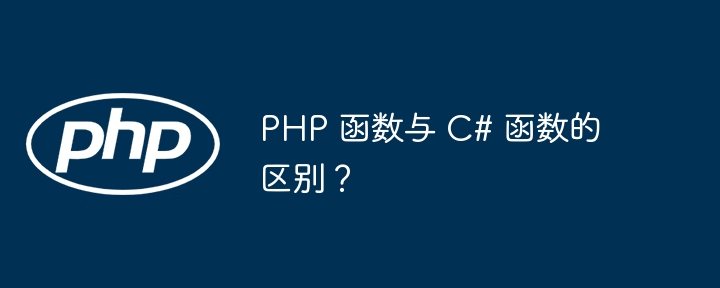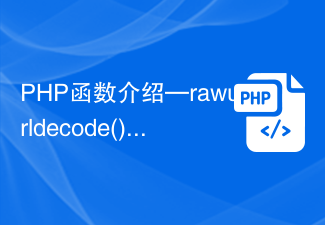PHP function consists of function header, function parameters, function body and return value: function header contains function name, parameter list and optional return value type. Function parameters are variables passed into the function. The function body executes the code to be executed. A function can return a value via the return statement, the type of which is optionally specified in the function header.

Parts of a PHP function
A PHP function is a predefined block of code that performs a specific task. It consists of the following components:
1. Function header
The function header specifies the name, parameter list and return value type of the function (optional):
function function_name(argument1, argument2, ...): return_type {
// 函数体
}For example:
function greet(string $name): string {
return "Hello, $name!";
}2. Function parameters
Function parameters are variables or values that are passed to the function. They are specified in the function header, and the type and name are optional.
3. Function body
The function body contains the code to be executed. It is located between the function header and the curly braces {}.
4. Return value
The function can return a value, specified by the return statement. The return type is specified in the function header (optional).
Practical case
Consider a function that calculates the sum of two numbers:
function sum(int $a, int $b): int {
return $a + $b;
}
// 调用函数
$result = sum(10, 20);
echo $result; // 输出: 30Notes
- Function names are size-sensitive in PHP Write.
- The type and name of the parameters are optional but critical to the robustness and readability of the code.
- If a function does not explicitly declare a return value type, it will return
void(None) by default.
The above is the detailed content of What are the components of a PHP function?. For more information, please follow other related articles on the PHP Chinese website!
 如何使用 PHP 函数进行数据预处理?May 02, 2024 pm 03:03 PM
如何使用 PHP 函数进行数据预处理?May 02, 2024 pm 03:03 PMPHP数据预处理函数可用于进行类型转换、数据清理、日期和时间处理。具体来说,类型转换函数允许变量类型转换(例如int、float、string);数据清理函数可删除或替换无效数据(如is_null、trim);日期和时间处理函数可进行日期转换和格式化(如date、strtotime、date_format)。
 PHP 函数的链式调用和闭包Apr 13, 2024 am 11:18 AM
PHP 函数的链式调用和闭包Apr 13, 2024 am 11:18 AM是的,可以通过链式调用和闭包优化代码简洁性和可读性:链式调用可将函数调用链接为一个流畅接口。闭包可创建可重用代码块,并在函数外部访问变量。
 PHP 函数与 C# 函数的区别?Apr 25, 2024 pm 05:36 PM
PHP 函数与 C# 函数的区别?Apr 25, 2024 pm 05:36 PMPHP和C#函数的区别:概念:PHP函数用于特定任务,C#函数用于封装代码。语法:PHP函数使用function关键字,C#函数使用publicstaticvoid关键字。返回类型:PHP函数可以返回任何类型,C#函数必须指定返回类型。命名空间:PHP函数可在全局命名空间或特定命名空间中定义,而C#函数必须定义在类或命名空间中。作用域:PHP函数在定义范围可见,C#函数在声明的命名空间或类中可见。参数:PHP函数参数按值传递,可有默认值;C#函数参数按值或引用传递,无默认值。
 解决 PHP 函数兼容性问题的最佳实践May 01, 2024 pm 02:42 PM
解决 PHP 函数兼容性问题的最佳实践May 01, 2024 pm 02:42 PM最佳实践解决PHP函数兼容性问题:使用版本化的函数名称(例如:array_map_recursive())利用函数别名(例如:functionarray_map($callback,$array){...})检查函数可用性(例如:if(function_exists('array_map_recursive')){...})使用命名空间(例如:namespaceMyNamespace{...})
 PHP 函数的访问控制级别有哪些?Apr 11, 2024 am 10:06 AM
PHP 函数的访问控制级别有哪些?Apr 11, 2024 am 10:06 AMPHP函数的访问控制级别有3个:public、protected、private。public函数可从任何地方访问,protected函数仅限于自身类和子类访问,private函数仅限于自身类访问。修改访问控制级别时,只需在函数声明前添加相应关键字,例如publicfunction、protectedfunction、privatefunction。
 深度解读Linux协议栈的关键组成部分Mar 20, 2024 pm 12:39 PM
深度解读Linux协议栈的关键组成部分Mar 20, 2024 pm 12:39 PMLinux操作系统作为一个开源系统,在网络通信领域表现出色,其中的协议栈被认为是关键组成部分之一。在本文中,我们将深度解读Linux协议栈的关键组成部分,包括网络接口、套接字、TCP/IP协议栈等,通过具体的代码示例来帮助读者更好地理解。1.网络接口网络接口是Linux协议栈中最底层的一个组成部分,负责实现网络数据包的收发。在Linux中,网络接口通过设备
 PHP函数介绍—rawurldecode(): 对URL进行解码Jul 24, 2023 pm 11:46 PM
PHP函数介绍—rawurldecode(): 对URL进行解码Jul 24, 2023 pm 11:46 PMPHP函数介绍—rawurldecode():对URL进行解码在进行Web开发中,我们经常需要处理URL,而URL中的特殊字符需要进行编码才能被正确地传递和解析。而在部分情况下,我们需要对URL进行解码,将编码后的字符串还原为原始的URL。PHP提供了一系列函数来处理URL编码和解码的问题,其中之一就是rawurldecode()函数。rawurldeco
 PHP 函数的构成部分是什么?Apr 10, 2024 pm 06:09 PM
PHP 函数的构成部分是什么?Apr 10, 2024 pm 06:09 PMPHP函数由函数头、函数参数、函数体和返回值组成:函数头包含函数名称、参数列表和可选返回值类型。函数参数是传入函数的变量。函数体执行要执行的代码。函数可以通过return语句返回一个值,其类型在函数头中指定(可选)。


Hot AI Tools

Undresser.AI Undress
AI-powered app for creating realistic nude photos

AI Clothes Remover
Online AI tool for removing clothes from photos.

Undress AI Tool
Undress images for free

Clothoff.io
AI clothes remover

AI Hentai Generator
Generate AI Hentai for free.

Hot Article

Hot Tools

Dreamweaver CS6
Visual web development tools

SecLists
SecLists is the ultimate security tester's companion. It is a collection of various types of lists that are frequently used during security assessments, all in one place. SecLists helps make security testing more efficient and productive by conveniently providing all the lists a security tester might need. List types include usernames, passwords, URLs, fuzzing payloads, sensitive data patterns, web shells, and more. The tester can simply pull this repository onto a new test machine and he will have access to every type of list he needs.

MantisBT
Mantis is an easy-to-deploy web-based defect tracking tool designed to aid in product defect tracking. It requires PHP, MySQL and a web server. Check out our demo and hosting services.

mPDF
mPDF is a PHP library that can generate PDF files from UTF-8 encoded HTML. The original author, Ian Back, wrote mPDF to output PDF files "on the fly" from his website and handle different languages. It is slower than original scripts like HTML2FPDF and produces larger files when using Unicode fonts, but supports CSS styles etc. and has a lot of enhancements. Supports almost all languages, including RTL (Arabic and Hebrew) and CJK (Chinese, Japanese and Korean). Supports nested block-level elements (such as P, DIV),

ZendStudio 13.5.1 Mac
Powerful PHP integrated development environment







